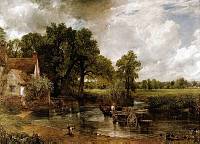
The Hay Wain by John Constable
The most famous of all Constable paintings, The Hay Wain. Constable’s painting shows a rural scene in Suffolk, near Flatford on the River Stour. The hay wain, a type of horse-drawn cart, stands in the water in the foreground. Across the meadow in the distance on the right, is a group of haymakers at work. The cottage shown on the left was rented by a farmer called Willy Lott and stands behind Flatford Mill. Constable also painted Willy Lott’s cottage.
Although the painting is of a Suffolk scene, it was painted in Constable’s studio in London. He first made a number of open-air sketches of parts of the scene and then made a full-size sketch in oil before painting the final result.
The painting was exhibited at the Royal Academy in 1821, the year it was painted, but failed to find a buyer. Later opinion changed and it is now considered to be one of the greatest and most popular English paintings.
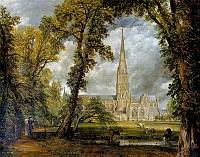
Salisbury Cathedral by John Constable
Salisbury Cathedral from the Bishop’s Grounds painted in 1823. Salisbury Cathedral is one of England’s most famous churches and is one of Constable’s most celebrated works. It was commissioned by one of his close friends, John Fisher, The Bishop of Salisbury.
Constable visited Salisbury in 1820 and made a series of oil sketches of the cathedral, which served as the model for this composition. He selected a viewpoint from the bishop’s garden and included figures of Dr. Fisher and his wife at the bottom left. Following its exhibition at the 1823 Royal Academy, Constable observed: “My Cathedral looks very well….It was the most difficult subject in Landscape I ever had upon my Easel. I have not flinched at the work of the windows, buttresses, &c. – but I have as usual made my escape in the Evanescence of the Chiaro-Oscuro“. The bishop did not like the dark cloud over the cathedral, and when he commissioned a smaller replica, requested “a more serene sky”.
The painting embodies the full range of qualities of a quintessentially British landscape painting – the clouds, trees, a water meadow, cattle drinking at the edge of the pasture and the glorious architecture of a medieval cathedral – all on a human scale.
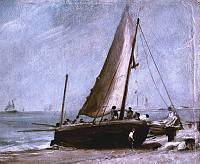
Brighton beach, Fishing boat and crew by John Constable
Oil painting, 1824. Constable himself seems to have rather scorned this beautiful painting: he writes an unflattering description of Brighton and concludes: “In short there is nothing here for a painter but the breakers-& sky-which have been lovely indeed and always varying. The fishing boats are picturesque, but not so much so as the Hasting boats which are luggers … But these subjects are so hackneyed in the Exhibition, and are in fact so little capable of that beautifull sentiment that landscape is capable of or which rather belongs to landscape, that they have done a great deal of harm to the art -they form a class of art much easier than landscape & have in consequence almost supplanted it … ”
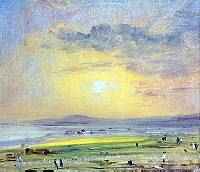
Coast Scene at Brighton by John Constable, c 1820
John Constable (RA), Coast Scene at Brighton: Evening, oil on paper, 1828. This view is ofhe setting sun over Shoreham-by-Sea, west of Brighton. The location was praised as ‘one of the most pleasant and rural situations in the vicinity’.
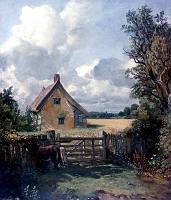
Cottage in a cornfield by John Constable
Though left unfinished until March 1833, Constable based the donkey in this painting on a life study done in December 1815. The corn in the field remains green on the side shaded from the sun, but is ripe elsewhere, suggesting it is set in the month of July.
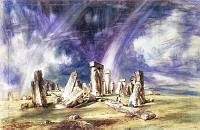
Stonehenge, Constable c1835
Constable painted this watercolour at a sad time in his life. Both his wife, Maria, and his closest friend, John Fisher Bishop of Salisbury, had died, and his two eldest sons had left home. He is perhaps expressing his personal unhappiness in the watercolour, for the image is certainly a melancholy one. The painting was exhibited in the Royal Academy Summer Exhibition of 1836. Some of the lines that accompanied this painting in the catalogue describe ‘The mysterious monument of Stonehenge, standing remote on a bare and boundless heath…’.
To return to John Constable paintings as prints, click here
To visit all painters and choose a different painter, go to Home